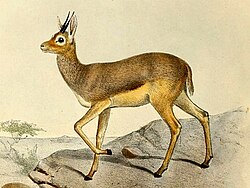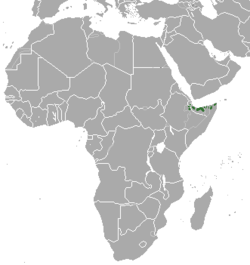Habits
Beira have only been recorded giving birth in April at the height of the rainy season. Gestation lasts six months and one calf is born. They are most active in the early morning and late afternoon, and rest in the middle of the day. They are extremely wary, and are alerted to the slightest disturbance by their excellent hearing, moving off with great speed across the scree on the rocky slopes, bounding with agility from rock to rock on steeper, less broken terrain. Beira are adapted to arid climate and do not need to find water, as they obtain all they need from the plants they browse. Beira typically live in territorial groups of two to five individuals, including only one adult male [5] , but larger groups have been recorded and these probably occur when family groups meet up. Beira are predominantly browsers [6] , but also graze when grass is available. Hyenas, caracals and jackals are the main predators of beira, and where they occur lions and leopards will take them too. [3]
Conservation
The beira is subject to some low level hunting but its small size, extreme wariness, and the inaccessible rocky habitat may allow it to withstand hunting pressure. Overgrazing by domestic goats, drought and cutting of acacia scrub for charcoal production are thought to be greater threats [6] [7] [8] . It is listed as Vulnerable by the IUCN. [1] In Djibouti it is thought to be rare but not endangered. [9] and its status in Ethiopia is currently unknown, the last record being in 1972. [1]
The only captive breeding group of beira was at Al Wabra Wildlife Preservation where they have been successfully bred and the number reached a peak of 58 in 2005. [10]
This page is based on this
Wikipedia article Text is available under the
CC BY-SA 4.0 license; additional terms may apply.
Images, videos and audio are available under their respective licenses.


